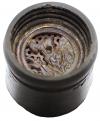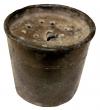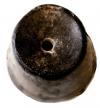

2. Page Marker
4. Seals
5. Rowels
8. Tweezers
9. Pricker
10. Leads
11. Quill Pens
12. Four-flanged Pen
13. Stylus
14. Penners
15. Firelighter Iron
16. Tooth Burnisher
17. Medieval Inks
18. Lead Inkwell
19. Inkhorn
Title Sander (or Pounce Pot)








Brief description The sander, otherwise known as a pounce pot, functions in a very similar manner to a salt shaker, and would have been filled with a finely ground powder (pumice, gum-sandarac rosin, or the crushed bones of cuttlefish). Generally no larger than a clenched fist, a sander’s perforated tops allowed fine powders to be gently shaken over a writing surface. It could be fashioned from a variety of materials, including pewter, silver, brass, bronze, wood, or bone, while the idiosyncratically designed (and more expensive) implements were decorated with enamel or rendered in outlandish shapes (like this imaginative mermaid's tail). The Cole Collection’s Mermaid Tail Sander, from the 17th century, comes from the collection of scribe Alfred Fairbank. This sander has a hinged brass cap with perforated convex dome that would be unlatched for the user to fill with pounce or sand. The hollowed horn body has two rounded brass feet so that it can rest steadily on a desk's surface, with a brass symmetrical “tail” fastened to the sander’s tip. The Cole Collection’s Bronze Sander, from the mid/late 15th century, is a more traditional example. Measuring 42mm in height with a top diameter of 45mm and a base diameter of 33mm, this sander is about the size and shape of a stoppage cork for plugging vessels. It has a flat, perforated top and a small hole in its base that could be plugged with a pinch of wax. When it needed to be refilled, the wax could be melted, removed, and replaced to prevent the contents from drizzling out. Although its precise use varied depending on the scribe’s writing surface and likely the time frame in which he would have completed these manuscripts, there seem to be two logical possibilities. The first known technique for this tool was to shake a small amount of the substance over clean paper (or parchment which could exhibit a residual greasiness) and gently buff the particles so as to soften and brighten the surface. By doing so, the paper would become smoother and would make the carefully scripted text less susceptible to bleeding in the fibrous texture. The preparer must be careful to not over–buff the page; paper that is too smooth can create a slick surface that makes controlling one’s writing hand even more challenging. The paper or parchment must be carefully brushed to remove any remaining granules; if left on the surface, the leftover powder will quickly clog the nib and can be transmitted into the ink. Concordantly, this additional process of delicately sanding the surface was viewed as superfluous by some for slowing production and increasing the level of difficulty. The second technique, employed around the late 18th century, utilized the pounce dispersed from the pounce pot/sander to lightly sprinkle the fine powder over freshly scripted text. For this method, the pounce could also be made from fine sand or a powdered mineral, such as sandstone or talc (by then, sandarac-resin had fallen out of fashion). The pounce would absorb any excess ink from the paper’s surface, expediting drying time on the newly–introduced coated paper. This was a precursor to blotting paper. Although scribes would ideally want to let the ink dry on its own, this took time. Pounce accelerated the time it took for wet script to dry so the reverse side could be worked on more quickly.
Contributor: Kira Fluor-Scacchi (with help from notes by Alan Cole)
Contribution date: Winter 2014